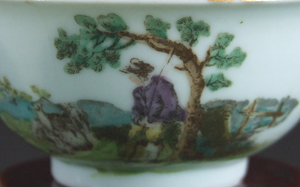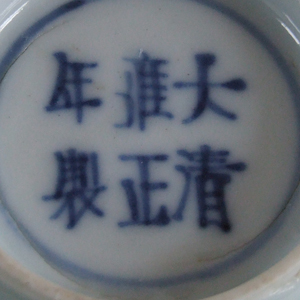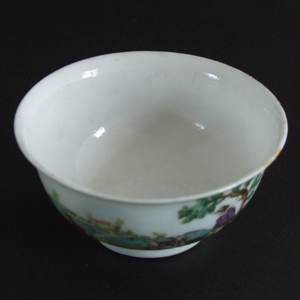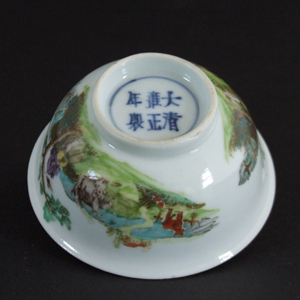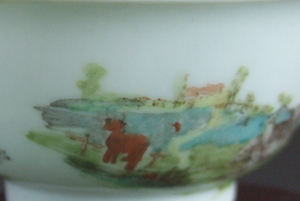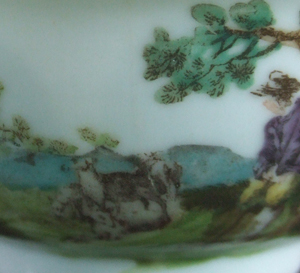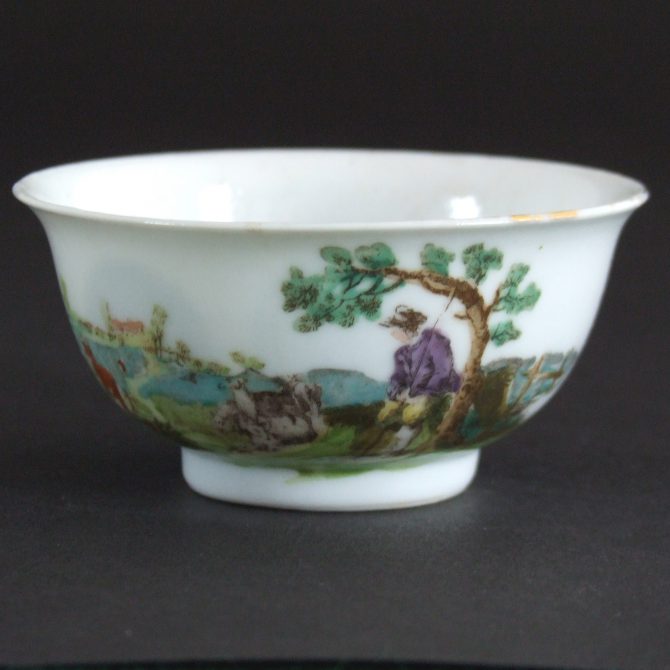
YONGZHENG 1723 – 1735 English Transfer Printed and Painted
A Rare English Transfer and Enamel Decorated Yongzheng Mark and Period Teabowl 1723-1735. The White Porcelain Teabowl with a Six Character Minyao (None-Imperial) Mark and of the Period 1723-1735. The English Transfer Print and Enamel c.1755-1758, Probably Decorated in the Midlands. The Scene Depicted is of a Rustic Landscape with a Shepard Casually Watching His Flock While Seated Under a Tree.
SOLD
- Condition
- Repaired.
- Size
- Diameter : 7 cm (2 3/4 inches)
- Provenance
- E&H Manners, 13th May 2004 The Helen Espir Collection of European Decorated Chinese Export Porcelain : "a member of the Oriental Ceramic Society and collector, with her husband. Having made a typical collection of Song and provincial Ming blue and white, they decided to concentrate on what used to be called `clobbered` porcelain. She is the author of the standard work on the subject, European Decoration on Oriental Porcelain,2005, the first to examine the work of European decorators on Chinese porcelain throughout the eighteenth and nineteenth centuries, focusing on enamellers in Holland, Germany and England. She has learned Chinese." From Provenance ; Collectors, Dealers & Scholars : Chinese Ceramics in Britain & America (Roy Davids, Dominic Jellinek, Privately Printed, 2011. ISBN 978-0-9570148-0-0).
- Stock number
- 23654
- References
- For a Chinese export porcelain teapot with this design see : The Watney Collection of Early English Porcelain, Part II. May 10th 2000. Phillips Bond Street, Lot 448. The catalogue states "This rare print resembles `Smoky Primitive` prints on Worcester porcelain datable to the mid-1750`s although so far it has only been recorded on Chinese porcelain. For a cream jug in this design see : Oriental Export Market Porcelain and its Influence on European Wares (Geoffrey A. Godden, Granada, 1979.ISBN 0246110570) page 371, plate 288. Geoffrey Godden notes that It is strange that the print has not yet been recorded on English porcelains-only Chinese. For a teabowl and saucer from E & H Manners see : European Decoration on Oriental Porcelain 1700 - 1830 (Helen Espir, Jorge Welsh Books, 2005) page 237, plate 41. Helen Espir suggests that it was probably decorated in the Midlands. A small group of this transfer printed and enamelled design is illustrated in : The Early James Giles and his Contemporary London Decorators (Stephen Hanscombe, Stockspring Antiques. 2008) page 150, plate 153.
Information
English transfer decorated Chinese export porcelain is one of the rarest groups of over-decorated porcelain. It is interesting to note that this early print has not been found on English porcelain, the addition of enamel is also highly unusual. The form of the teabowl as well as the quality of the paste point to the porcelain being the same as the mark. None-Imperial Kangxi mark and period porcelain is common but large numbers of none-imperial Yongzheng mark and period also exist. Pieces with four character Yongzheng marks were recovered from the `Ca Mau Cargo`.
Plain white 18th century Chinese export porcelain is rare, however there are many pieces from the 1750`s and 1760`s that were plain, then decorated in London enamelling workshops. So it seems likely they were part of specific orders of white porcelain solely for decoration in England. However the present example bares the six character mark of Yongzheng (1723-1735) so it appears this piece at least was in the West for some time before it was decorated.
